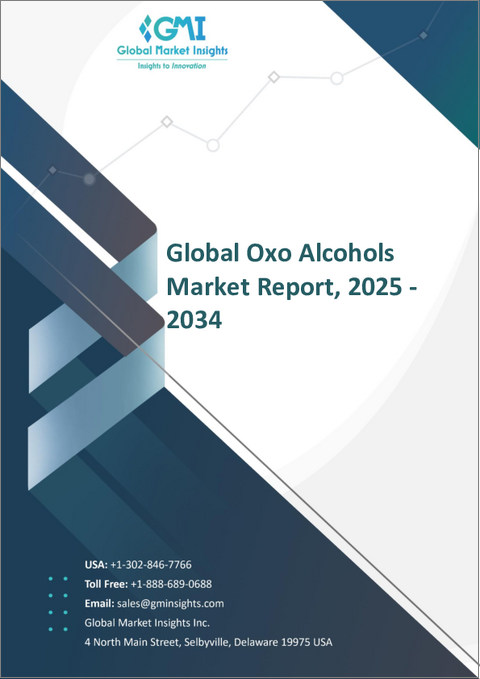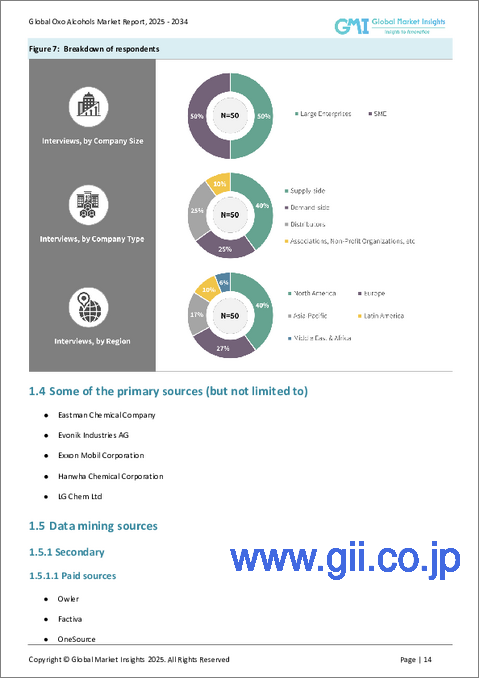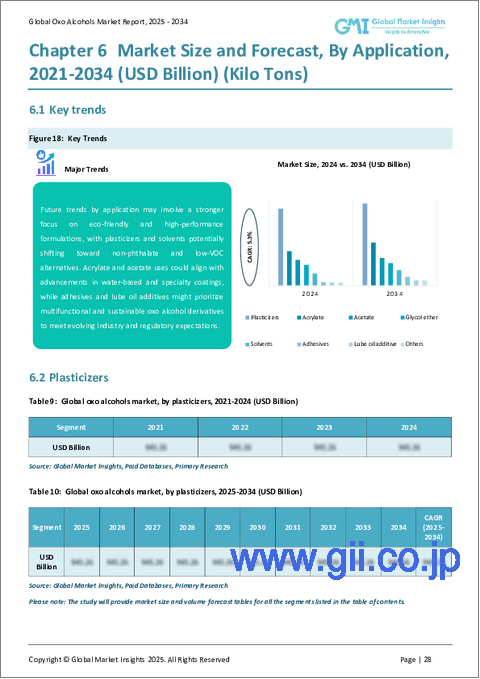|
|
市場調査レポート
商品コード
1628185
オキソアルコール市場の機会、成長促進要因、産業動向分析、2025~2034年予測Oxo Alcohols Market Opportunity, Growth Drivers, Industry Trend Analysis, and Forecast 2025 - 2034 |
||||||
カスタマイズ可能
|
|||||||
| オキソアルコール市場の機会、成長促進要因、産業動向分析、2025~2034年予測 |
|
出版日: 2024年11月26日
発行: Global Market Insights Inc.
ページ情報: 英文 200 Pages
納期: 2~3営業日
|
全表示
- 概要
- 目次
オキソアルコールの世界市場規模は2024年に215億米ドルとなり、2025年から2034年にかけてCAGR 5.3%で成長すると予想されています。
この成長は、アクリレートポリマーの生産に使用されるアクリレートの需要増と、自動車、建設、消費財など様々な産業における可塑剤の使用拡大が後押ししています。一酸化炭素、水素、オレフィンを組み合わせたヒドロホルミル化反応によって生成されるオキソアルコールは、数多くの産業用途で極めて重要です。
同市場の成長は、特に包装・建設分野での可塑剤ニーズの高まりと、印刷インキ、つや出し剤、クリーナーなどの溶剤配合におけるオキソアルコールの広範な使用によるところが大きいです。オキソアルコールは洗剤、化粧品、クリーニング製品の製造に不可欠であるため、パーソナルケアや家庭用品を含む消費者主導の産業も大きく貢献しています。
さらに、自動車や建設セクターの隆盛は、溶剤、コーティング剤、接着剤の製造にオキソアルコールの強い需要を生み出しています。さらに、持続可能な製造方法の推進は、環境への影響を最小限に抑えるという世界の規制動向に合わせて、環境に優しい製造方法の採用を促しています。こうした開発は、産業性能と持続可能性の両方の目標を達成する上で、オキソアルコールの重要性が高まっていることを裏付けています。
| 市場範囲 | |
|---|---|
| 開始年 | 2024 |
| 予測年 | 2025-2034 |
| 開始金額 | 215億米ドル |
| 予測金額 | 351億米ドル |
| CAGR | 5.3% |
製品タイプの中では、2-エチルヘキサノールが市場をリードすると予想され、CAGR 5.5%で2034年までに176億米ドルに達すると予測されます。n-ブタノールやiso-ブタノールのような他の変種も、プラスチック、特殊化学品、溶剤の製造に使用されるため、大きな市場シェアを占めています。これらの製品は汎用性が高く、多様な産業に適応できるため、需要が高まっています。
可塑剤セグメントは、予測期間中、大きな市場シェアを占め、堅調な成長を示し、アプリケーションランドスケープを支配すると予想されます。ポリマーの柔軟性と弾力性を高める上で重要な役割を果たす可塑剤は、さまざまな産業用途で不可欠な成分として位置づけられています。同様に、アクリレート、アセテート、グリコールエーテル、潤滑油添加剤も、コーティング剤、接着剤、パーソナルケア用品、潤滑油での使用により、安定した成長を遂げています。
米国では、オキソアルコール産業はCAGR 4.8%で成長し、2034年には68億米ドルに達すると予測されています。生産プロセスの進歩と、持続可能な低VOC製品へのシフトが、技術革新と効率性に重点を置いたこの成長の促進要因となっています。
目次
第1章 調査手法と調査範囲
第2章 エグゼクティブサマリー
第3章 業界洞察
- エコシステム分析
- バリューチェーンに影響を与える要因
- 利益率分析
- ディスラプション
- 将来の展望
- メーカー
- 流通業者
- サプライヤーの状況
- 利益率分析
- 主要ニュース
- 規制状況
- 影響要因
- 業界への影響要因
- 促進要因
- 消費者製品およびパーソナルケア用品の需要増加
- 自動車産業と建設産業の成長
- 持続可能で環境に優しい生産方法への注目の高まり
- 市場の課題
- 原材料価格の変動とサプライチェーンの混乱
- 促進要因
- 規制と市場への影響
- ポーター分析
- PESTEL分析
第4章 競合情勢
- イントロダクション
- 企業シェア分析
- 競合のポジショニング・マトリックス
- 戦略展望マトリックス
第5章 市場規模・予測:製品別、2021年~2034年
- 主要動向
- N-ブタノール
- 2-エチルヘキサノール
- イソブタノール
- その他
第6章 市場規模・予測:用途別、2021年~2034年
- 主要動向
- 可塑剤
- アクリレート
- アセテート
- グリコールエーテル
- 溶剤
- 接着剤
- 潤滑油添加剤
- その他
第7章 市場規模・予測:地域別、2021~2034年
- 主要動向
- 北米
- 米国
- カナダ
- 欧州
- 英国
- ドイツ
- フランス
- イタリア
- スペイン
- ロシア
- アジア太平洋
- 中国
- インド
- 日本
- 韓国
- オーストラリア
- ラテンアメリカ
- ブラジル
- メキシコ
- 中東・アフリカ
- 南アフリカ
- サウジアラビア
- アラブ首長国連邦
第8章 企業プロファイル
- Andhra Petrochemicals
- BASF
- Bax Chemicals
- Eastman Chemical
- Elekeiroz
- Evonik Industries
- Exxon Mobil Corporation
- Grupa Azoty ZAK S.A.
- Hanwha Chemical Corporation
- LG Chem
The Global Oxo Alcohols Market was valued at USD 21.5 billion in 2024 and is expected to grow at a CAGR of 5.3% from 2025 to 2034. This growth is fueled by the increasing demand for acrylates used in producing acrylate polymers and the expanding use of plasticizers across various industries such as automotive, construction, and consumer goods. Oxo alcohols, created through the hydroformylation reaction by combining carbon monoxide, hydrogen, and olefins, are crucial in numerous industrial applications.
The market's growth is largely attributed to the rising need for plasticizers, particularly in the packaging and construction sectors, and their extensive use in solvent formulations for printing inks, polishes, and cleaners. Consumer-driven industries, including personal care and household products, also contribute significantly, as oxo alcohols are integral in manufacturing detergents, cosmetics, and cleaning products.
Moreover, the flourishing automotive and construction sectors are creating a strong demand for oxo alcohols in producing solvents, coatings, and adhesives. Additionally, the push for sustainable manufacturing practices is encouraging the adoption of eco-friendly production methods, aligning with global regulatory trends to minimize environmental impact. These developments underline the growing importance of oxo alcohols in achieving both industrial performance and sustainability goals.
| Market Scope | |
|---|---|
| Start Year | 2024 |
| Forecast Year | 2025-2034 |
| Start Value | $21.5 Billion |
| Forecast Value | $35.1 Billion |
| CAGR | 5.3% |
Among the product types, 2-ethylhexanol is anticipated to lead the market, projected to reach USD 17.6 billion by 2034, with a CAGR of 5.5%. Other variants like n-butanol and iso-butanol also hold significant market shares due to their applications in manufacturing plastics, specialty chemicals, and solvents. These products are experiencing rising demand due to their versatile properties and adaptability across diverse industries.
The plasticizers segment is expected to dominate the application landscape, holding a significant market share and exhibiting robust growth during the forecast period. Their critical role in enhancing the flexibility and resilience of polymers positions them as essential components in various industrial applications. Similarly, acrylates, acetates, glycol ethers, and lube oil additives are experiencing steady growth due to their use in coatings, adhesives, personal care items, and lubricants.
In the U.S., the oxo alcohols industry is projected to grow at a CAGR of 4.8%, reaching USD 6.8 billion by 2034. Advancements in production processes and a shift towards sustainable, low-VOC products are driving this growth, with a strong focus on innovation and efficiency.
Table of Contents
Chapter 1 Methodology & Scope
- 1.1 Market scope & definition
- 1.2 Base estimates & calculations
- 1.3 Forecast calculation
- 1.4 Data sources
- 1.4.1 Primary
- 1.4.2 Secondary
- 1.4.2.1 Paid sources
- 1.4.2.2 Public sources
Chapter 2 Executive Summary
- 2.1 Industry synopsis, 2021-2034
Chapter 3 Industry Insights
- 3.1 Industry ecosystem analysis
- 3.1.1 Factor affecting the value chain
- 3.1.2 Profit margin analysis
- 3.1.3 Disruptions
- 3.1.4 Future outlook
- 3.1.5 Manufacturers
- 3.1.6 Distributors
- 3.2 Supplier landscape
- 3.3 Profit margin analysis
- 3.4 Key news & initiatives
- 3.5 Regulatory landscape
- 3.6 Impact forces
- 3.7 Industry impact forces
- 3.7.1 Growth drivers
- 3.7.1.1 Increasing demand for consumer products and personal care items
- 3.7.1.2 Growth in the automotive and construction industries
- 3.7.1.3 Rising focus on sustainable and eco-friendly production practices
- 3.7.2 Market challenges
- 3.7.2.1 Volatility in raw material prices and supply chain disruptions
- 3.7.1 Growth drivers
- 3.8 Regulations & market impact
- 3.9 Porter's analysis
- 3.10 PESTEL analysis
Chapter 4 Competitive Landscape, 2024
- 4.1 Introduction
- 4.2 Company market share analysis
- 4.3 Competitive positioning matrix
- 4.4 Strategic outlook matrix
Chapter 5 Market Size and Forecast, By Product, 2021-2034 (USD Billion) (Kilo Tons)
- 5.1 Key trends
- 5.2 N-Butanol
- 5.3 2-Ethylhexanol
- 5.4 Iso-butanol
- 5.5 Others
Chapter 6 Market Size and Forecast, By Application, 2021-2034 (USD Billion) (Kilo Tons)
- 6.1 Key trends
- 6.2 Plasticizers
- 6.3 Acrylate
- 6.4 Acetate
- 6.5 Glycol ether
- 6.6 Solvents
- 6.7 Adhesives
- 6.8 Lube oil additive
- 6.9 Others
Chapter 7 Market Size and Forecast, By Region, 2021-2034 (USD Billion) (Kilo Tons)
- 7.1 Key trends
- 7.2 North America
- 7.2.1 U.S.
- 7.2.2 Canada
- 7.3 Europe
- 7.3.1 UK
- 7.3.2 Germany
- 7.3.3 France
- 7.3.4 Italy
- 7.3.5 Spain
- 7.3.6 Russia
- 7.4 Asia Pacific
- 7.4.1 China
- 7.4.2 India
- 7.4.3 Japan
- 7.4.4 South Korea
- 7.4.5 Australia
- 7.5 Latin America
- 7.5.1 Brazil
- 7.5.2 Mexico
- 7.6 MEA
- 7.6.1 South Africa
- 7.6.2 Saudi Arabia
- 7.6.3 UAE
Chapter 8 Company Profiles
- 8.1 Andhra Petrochemicals
- 8.2 BASF
- 8.3 Bax Chemicals
- 8.4 Eastman Chemical
- 8.5 Elekeiroz
- 8.6 Evonik Industries
- 8.7 Exxon Mobil Corporation
- 8.8 Grupa Azoty ZAK S.A.
- 8.9 Hanwha Chemical Corporation
- 8.10 LG Chem






